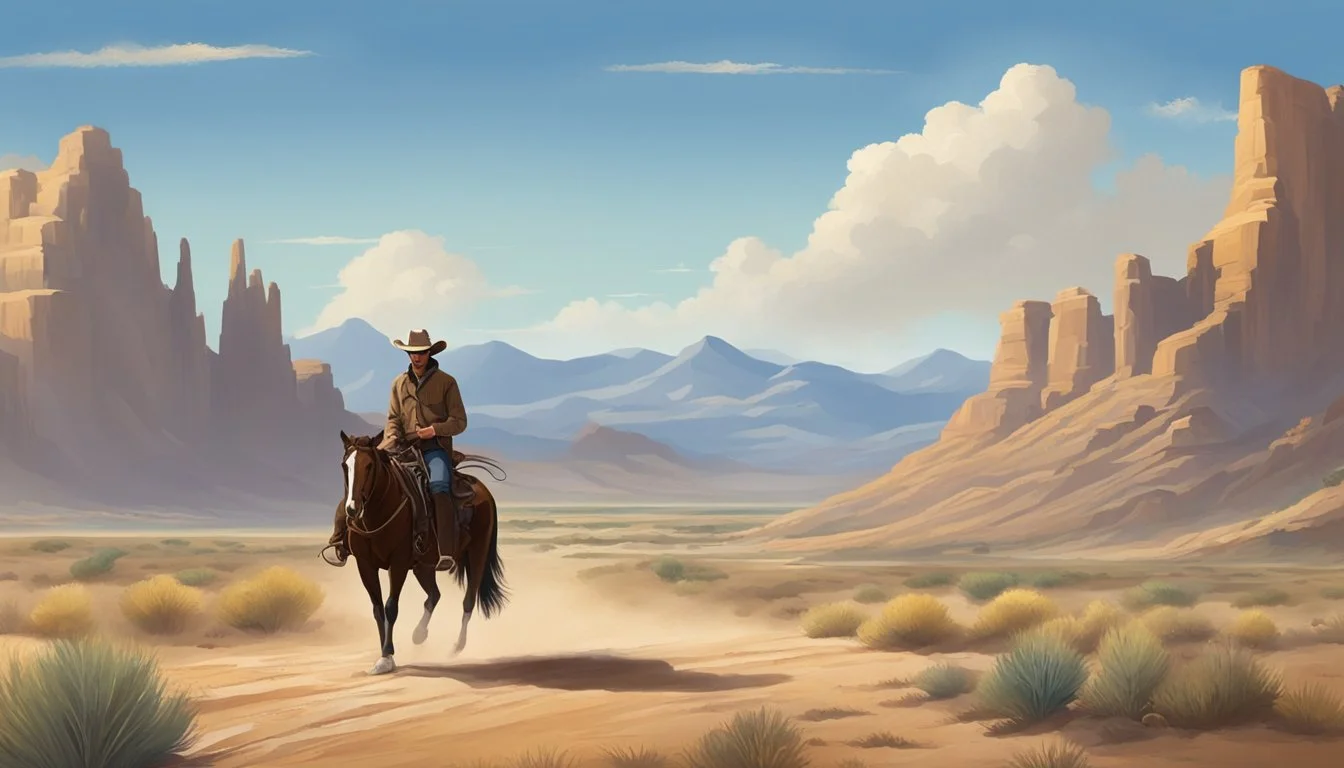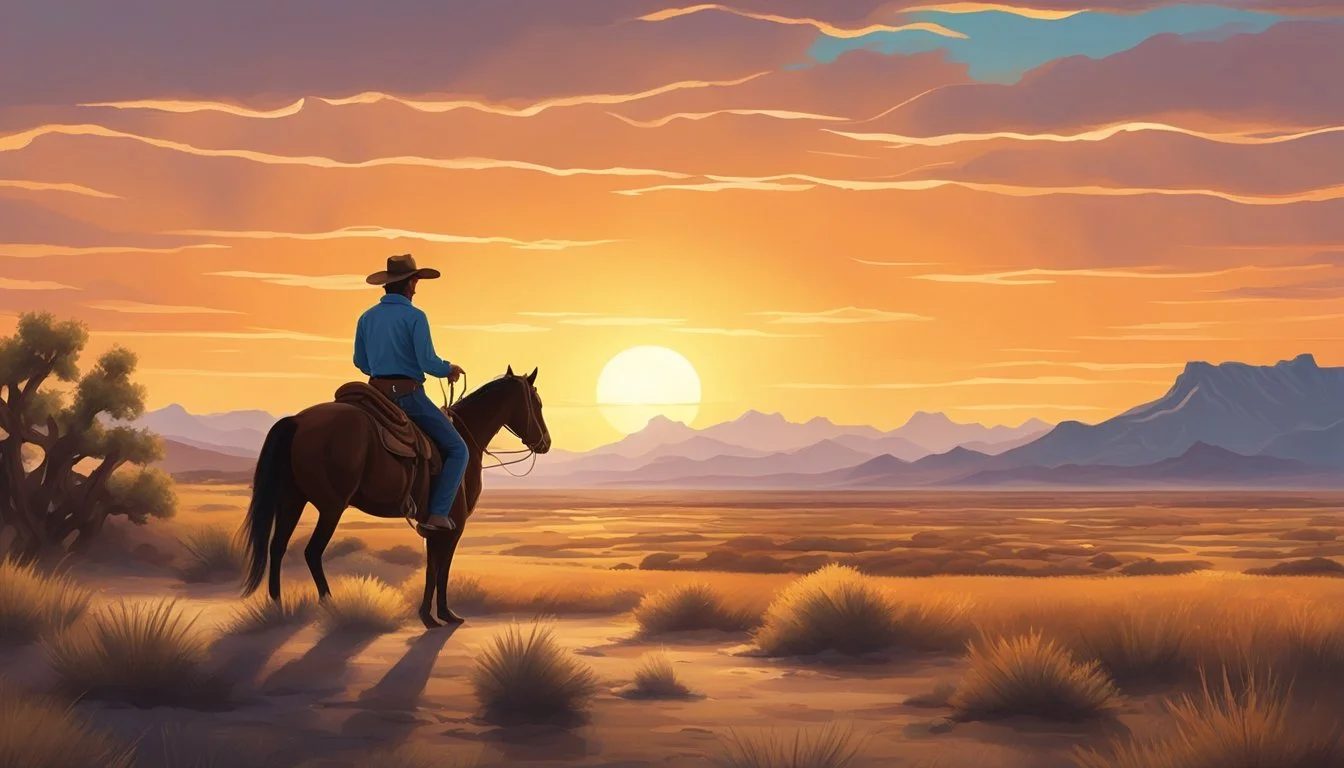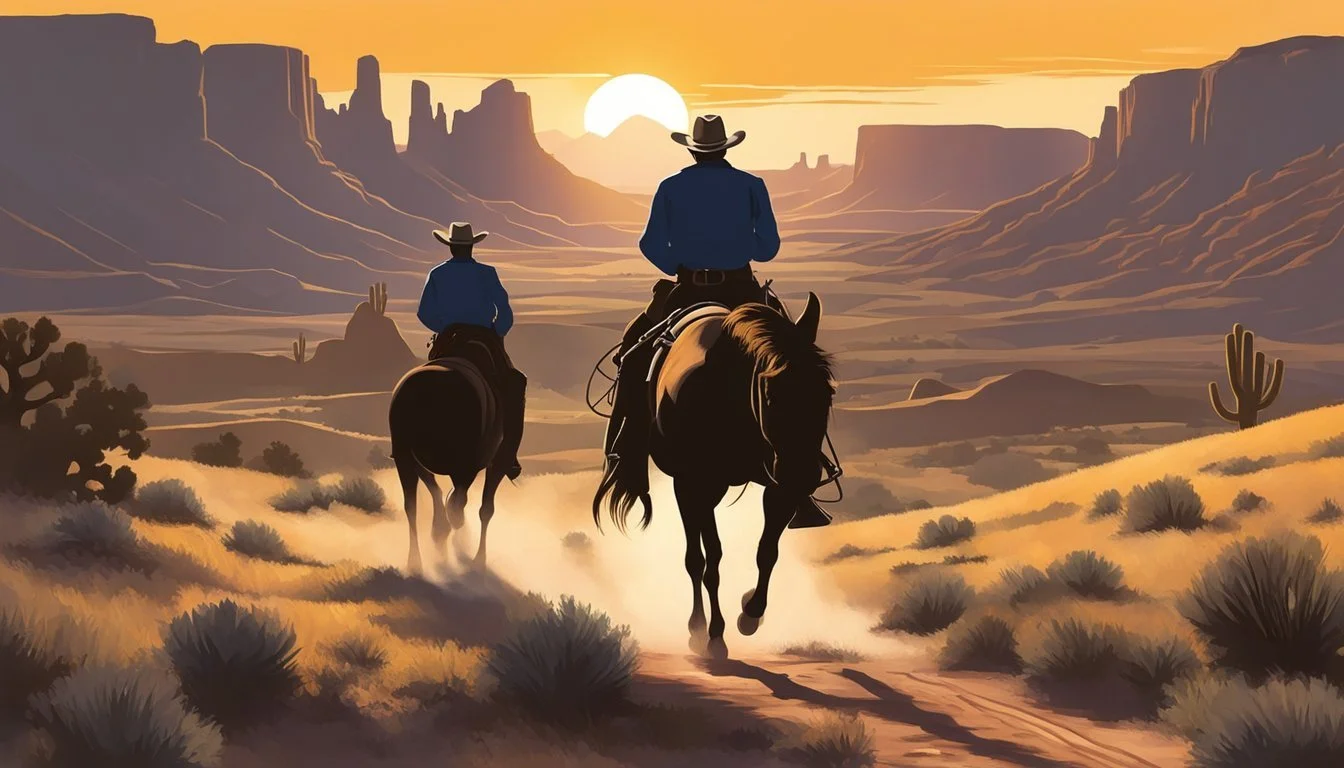The Texas Cowboy in Film
Hollywood's Role in Crafting the Iconic Lone Star Persona
The Texas cowboy is an indelible symbol of the American frontier, immortalized by Hollywood's portrayal of the Lone Star State. Films have played a significant role in shaping the image of Texas cowboys, often emphasizing characteristics such as rugged individualism and a strong connection to the land. As these narratives unfolded onscreen, they reinforced a cultural identity that resonates with the spirit of Texas and its historical legacy.
This cinematic tradition took root in the early days of film, where the cowboy emerged as a heroic figure against the vast, untamed backdrop of the West. Hollywood's portrayal contributed to the mystique of the Texas cowboy, weaving together fact and fiction to create characters that personified the values and myths of the time. The cowboy's portrayal in film has evolved over the years, reflecting changing attitudes and a deeper understanding of Texas history and its diverse culture.
While the cowboy's image has been romanticized, the reality of the Texas cowboy's influence extends beyond the screen. It is a legacy that encompasses the state's Spanish roots, where the vaqueros displayed their skill in horsemanship and cattle herding. Through cinematic storytelling, Hollywood has highlighted these aspects, celebrating the cowboy as not just a regional icon but as an integral part of the American cultural tapestry.
The Historical Context of the Texas Cowboy
The Texas cowboy emerged from a rich historical tapestry, strongly influenced by the skilled vaqueros of Spanish origins and shaped by the demands of the burgeoning cattle industry in the American West.
Evolution from Vaqueros to Cowboys
Vaqueros, the predecessors of the American cowboy, were expert horsemen and cattle herders who originated from Mexico during its colonial period under Spanish rule. The skills and techniques developed by vaqueros for ranching and herding were essential to the cowboy culture that later dominated Texas. Ranching necessitated a unique set of skills in horsemanship, roping, and cattle management, which were passed down and refined over time.
As Texas changed hands through the 19th century, first as a part of Mexico, then as an independent republic, and finally as a state of the United States, the vaquero tradition mingled with Anglo and African American influences to shape what would become the iconic Texas cowboy.
The Cattle Industry and the Wild West
The rise of the cattle industry in the 19th century was a driving force behind the Wild West's expansion and the cowboy's role within it. Texas became the heart of this burgeoning industry due to its vast open ranges and the Chisholm Trail, a major route that facilitated large-scale cattle drives to railheads in Kansas.
1830s - 1840s: Large herds of cattle were driven from Texas to markets in the North.
Post-Civil War Era: Cattle drives peak, with cowboys playing a pivotal role.
However, it was not merely a time of opportunity but also a period marked by harsh conditions, lawlessness, and conflict. This historical backdrop contributed to the cowboy’s storied image as a rugged and solitary figure, embodying the spirit of the Wild West ethos that Hollywood would later coopt and romanticize in films.
Early Portrayals of Texas Cowboys in Hollywood
Hollywood's depiction of Texas cowboys evolved from simplistic characterizations to complex, mythic figures, shaping the global image of the Lone Star State's iconic horsemen.
John Wayne and the Rise of Westerns
John Wayne emerged as a seminal figure in Hollywood, effectively becoming the embodiment of the Texas cowboy. He starred in numerous Western films that popularized cowboy traits such as courage, ruggedness, and a unique moral code. One of Wayne's most notable roles was in "The Searchers" (1956), directed by John Ford. This film showcased the Texas cowboy as a resilient and heroic figure, persisting against the harsh wilderness and moral ambiguities of the Wild West.
The Influence of John Ford on the Cowboy Genre
John Ford played a pivotal role in the crafting of the Texas cowboy image through his influential Westerns. Ford's films were known for their scenic landscapes and complex characters, and he frequently collaborated with John Wayne. Their works not only entertained but also elevated the Western genre, contributing to the cultural lore of Texas and the American West. Ford's portrayal of cowboys added depth to the archetype, highlighting personal struggles and a humanizing portrayal of Western life.
Cultural Impact and Stereotypes
Hollywood's cinematic portrayal of Texas cowboys has been pivotal in shaping both national identity and international perceptions of the American West. Film audiences have been presented with a mixture of fact and fiction that has influenced the collective consciousness regarding the cowboy lifestyle.
The Lone Star Image and National Identity
In films, the Lone Star image often depicts cowboys as rugged individualists, embodying freedom and self-reliance. This persona has seeped into the fabric of American national identity. Films such as "The Magnificent Seven" contribute to this idealized vision, presenting cowboys as heroes who reflect the pioneering ethos of the nation. However, this portrayal can oversimplify a diverse history, understating the realities of the cowboy life and its true social dynamics.
Racism and Representation of Native Americans and Black Cowboys
Representation of Native Americans and Black Cowboys in Westerns has been a subject of controversy. Historical accounts acknowledge the presence of African American cowboys, who made up a significant percentage of the workforce in ranching and cattle drives. Yet, Racism has often led to their underrepresentation or stereotypical portrayals in film.
Native Americans, similarly, have been misrepresented, typically depicted as adversaries to cowboys and settlers, perpetuating negative stereotypes. More recent works strive to provide a more nuanced and respectful representation, acknowledging the contributions and presence of non-white individuals in the West's history. The progression towards inclusive storytelling is gradually correcting the record and broadening the cultural understanding of the American frontier.
Modern Depictions of Texas in Film
Recent cinematic endeavors have evolved the representation of the Texas persona, revealing complexities of both its sprawling cityscapes and untamed countryside.
Filmmakers Shaping Contemporary Views
Directors and screenwriters have played pivotal roles in casting Texas in new light through film. Richard Linklater's Dazed and Confused and Friday Night Lights, directed by Peter Berg, depict Texan youth culture within its distinct eras, offering authentic visuals and narratives that resonate widely. No Country for Old Men by the Coen brothers eschews traditional cowboy tropes, instead presenting a stark, modern reality of rural Texas life. These films contribute to a layered, contemporary image of the state, discerning it as a hub not only for time-honored traditions but also for New Hollywood innovation.
Portrayal of Urban and Rural Divides
The juxtaposition of urban expansion against the vast rural backdrops is a recurrent theme in modern Texan films. Movies like Urban Cowboy and the legendary Giant provide a window into the evolving interaction between rapidly developing cities like Houston and San Antonio and the untamed frontier. They showcase Texas's dynamic progression from an agrarian society to a modern civilization, reflecting the cultural and societal shifts that have occurred. Austin has emerged as a cultural nexus, a representation of new filmmaking frontiers mirroring Texas's own fusion of the urban and the rural.
Significant Films and Characters
This section explores key Texas-based films and the unforgettable characters portrayed by renowned actors that have come to embody the rugged ethos of the Lone Star State.
Iconic Texas Films
"Lone Star" (1996): Directed by John Sayles, this film is a standout example of Texas storytelling. It intertwines personal and political threads, following Sheriff Sam Deeds (Chris Cooper) as he unravels a decades-old mystery.
"Texas Chainsaw Massacre" (1974): A game-changer in the horror genre that, while not directly showcasing the cowboy image, contributes to the ominous ambiance often associated with rural Texas landscapes.
Memorable Characters and Performances
John Sayles' "Lone Star"
Sam Deeds: Played by Chris Cooper, the character digs through the layered history of his father, Buddy Deeds (Matthew McConaughey), unraveling a complex legacy.
Buddy Deeds: Portrayed by Kris Kristofferson in flashbacks and Matthew McConaughey in the present, Buddy's past actions echo through the narrative, shaping the film's investigation into identity and history.
Pilar: Elizabeth Peña delivers a powerful performance as the character dealing with the town's intricate social and racial dynamics.
James Dean: His role in "Giant" (1956) remains an iconic portrayal of a Texas rancher, embodying the transformation and ambition of the state itself.
Bonnie and Clyde (1969): Not traditional cowboys, but their film captures the rebellious spirit often romanticized in tales of the Lone Star State.
Behind the Scenes: Texas in Film Production
Texas has long served as an iconic landscape for Hollywood. Its diverse topography and rich history have made it an attractive site for various film productions. From urban centers like Austin and Houston to the legendary backdrop of The Alamo, the Lone Star State offers filmmakers an array of settings.
Filmmaking in the Lone Star State
Texas has been a significant player in the film industry, particularly for westerns during Hollywood's Golden Age. Productions here benefit from the Texas Film Commission, which helps promote the state as a destination for filmmaking. Austin has notably become a hub for filmmakers, with movies such as "Office Space" and "Slacker" showcasing the city's unique vibe. Pioneering directors often choose Texas for its production incentives and robust facilities that cater to both large studio features and independent cinema.
Texas Cities as Film Backdrops
Urban centers in Texas provide filmmakers with rich, varied locales.
Houston: Its modern skyline and diverse neighborhoods have featured in films looking for a cosmopolitan setting.
San Antonio: The city's historic sites, such as The Alamo, offer authentic visuals for stories with a historical angle.
Austin: Known for its indie film scene, it's been the backdrop for cult classics like "Office Space".
Fort Worth: Its traditional architecture and cowboy culture are ideal for films with a rustic American theme.
Locations within these cities have doubled for both quintessential American landscapes and international locales.
Cinema and Border Narratives
The border region in Texas has a complex narrative often explored in film. This area provides an authentic setting for tales of cross-cultural exchanges and frontier life. Films set along the Texas border, such as in Rio County, delve into themes of law, order, and the American identity. The physical and cultural landscapes of border towns serve as potent symbols in cinema, casting a spotlight on the issues and stories that emerge from these liminal spaces.
Critical Reception and Legacy
The Texas cowboy archetype in film has been both celebrated and scrutinized, acquiring a complex legacy through awards success and cultural assessments.
Award Winning Texas Films
Texas-themed films have garnered critical acclaim and have often been in the running for Academy Awards. Films like "The Last Picture Show" have not only portrayed the Texan landscape and its iconic cowboys but have also received critical accolades, bringing the regional mythos into the spotlight of national cinema. The Coen Brothers' "No Country for Old Men," while not strictly about cowboys, merges the Texas ethos with modern storytelling, earning it an Academy Award for Best Picture.
Cultural Analysis and Scholarly Perspectives
Scholars and cultural critics have dissected the portrayal of Texas cowboys in films, offering a range of opinions from glorification to critique. The cultural analysis often revolves around masculinity, the myth of the West, and the cultural identity of Texas as presented through movies. "Lone Star" serves as a pivotal film that engages with Texas history and identity, prompting scholars to explore the interplay between the state's past and its present-day reflections in cinema.
Texas Cowboy in Film: A Societal Mirror
The depiction of the Texas cowboy in film serves not only as entertainment but also as a cultural barometer, reflecting society's evolving views and myths about this iconic figure.
Perpetuation of Myths vs. Realistic Portrayals
Films have a long history of portraying Texas cowboys in mythical dimensions, often exaggerating their ruggedness and moral clarity. This is evident in the silent film era with actors like Tom Mix, who became synonymous with the cowboy way of life. However, there's been a pivot towards more realistic portrayals in recent years. The Last Picture Show, set in a small Texan town, delves into the raw and mundane aspects of cowboy life, moving away from glorified stereotypes and showing cowboys as complex, flawed individuals.
Mythical: Cowboys as relentless champions of justice.
Realistic: Cowboys facing ordinary challenges and moral dilemmas.
Changing Narratives and New Voices
As the cultural landscape shifts, so do the stories told through the lens of the Texas cowboy. Films like Lone Star explore cowboy narratives entwined with modern social issues, while No Country for Old Men presents a cowboy figure caught in contemporary crime, hinting at the obsolescence of traditional cowboy ideals in modern society. Additionally, the rise of indigenous narratives with films such as those depicting Comanche or Kiowa stories adds new layers to the portrayal of cowboys and their interactions with Native American tribes.
Traditional: The cowboy as a lone hero in a timeless struggle.
Contemporary: The cowboy navigating modern dilemmas, reflecting present-day complexities.
Era Depicted Films Themes Classic Western Silent films, early Westerns Idealism, simplicity Mid-20th Century The Last Picture Show Realism, community life Late 20th Century Lone Star Multiculturalism, generational change 21st Century No Country for Old Men Violence, moral ambiguity
Films set in Texas that depict cowboys continue to serve as a societal mirror, reflecting shifting values and the diverse narratives of American life.
Influence Beyond Cinema
The imagery and ethos of the Texas cowboy have extended well beyond the frames of film, deeply influencing American fashion, pop culture, music, and literature.
Impact on Fashion and Pop Culture
Fashion trends frequently borrow from the distinct appearance of the cowboy, characterized by items such as Stetson hats, boots, and denim jeans. These elements, popularized through Western movies, became emblematic of a rugged, self-sufficient lifestyle that resonates with the American spirit. Pop culture manifestations of the cowboy image include everything from Halloween costumes to high-end fashion reinterpretations on runways, emphasizing durability and functionality associated with the Lone Star persona.
Cowboys in Music and Literature
In music, the cowboy archetype is perpetuated through the country and western genres, evident in the works of artists like Willie Nelson and Johnny Cash. Their songs often narrate tales of heartache, adventure, and the quintessential cowboy lifestyle, continuing the legacy of the Western ethos. Literary works, too, depict this Lone Star image, with authors like Larry McMurtry shaping the cowboy into a complex character that is both heroic and flawed. The Western novel has maintained a steadfast presence in American literature, reflecting the enduring allure of the cowboy mythos.
Conclusion
The portrayal of Texas cowboys in film has significantly influenced the cultural identity of the Lone Star State. Through a mix of historical truths and Hollywood embellishments, cowboys have become emblematic of Texas's heritage. Films have often highlighted their skills in horsemanship and cattle herding, attributes tracing back to the early vaqueros.
Narratives in these movies interweave with the state's evolution, with characters that embody courage, freedom, and adventure. Lone Star is an example of a movie that both reflects and shapes this image, demonstrating how Texans perceive and express their history.
The cowboy archetype, a mixture of reality and fiction, continues to resonate with audiences globally. Texas's cultural presence in film serves as a conduit for its rich traditions to endure. The entertainment industry's role in sculpting the mythology around Texas cowboys ensures this legendary image persists in contemporary storytelling.
No table needed











